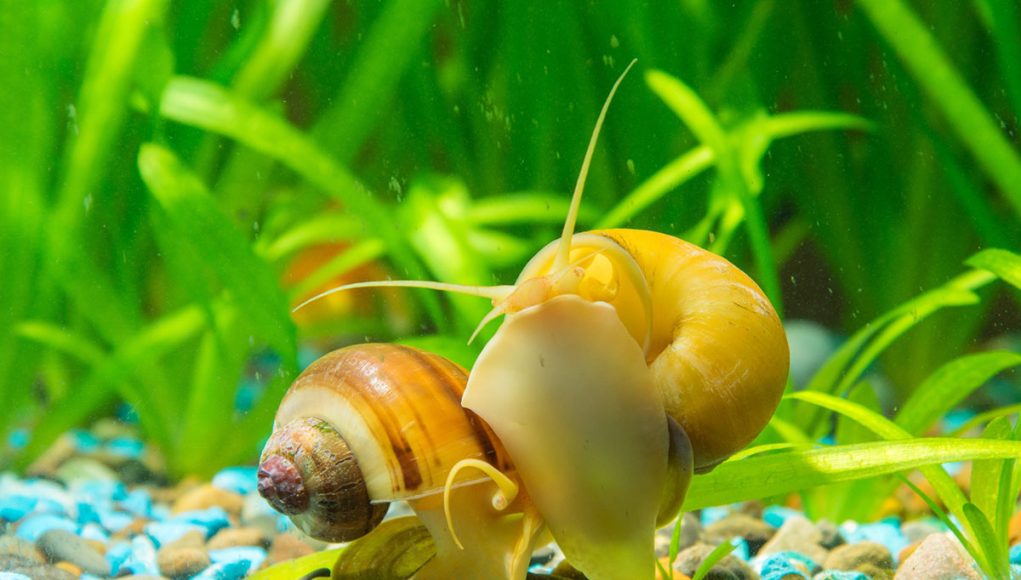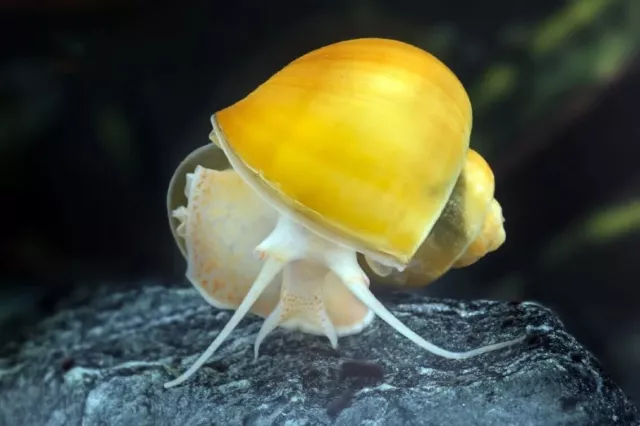The yellow ampullary (Pomacea bridgesii) is one of the most popular aquarium snails due to its bright color, peaceful behavior, and ability to purify water from food residues and algae. It is an excellent choice for both beginners and experienced aquarists. In addition to its beauty, this clam is also interesting for its unique biology and lifestyle.
In this article, we will look at the main characteristics of the yellow ampullary, its natural environment, behavior, nutrition, reproduction features and rules of care in the aquarium.

1. General characteristics and scientific classification
🔬 Scientific classification:
✔ The Kingdom: Animals (Animalia)
✔ Type: Shellfish (Mollusca)
✔ Class: Gastropods
✔ Row: Pulmonate snails (Ampullariidae)
✔ Family: Ampullariidae
✔ Gender: Pomacea
✔ View: Pomacea bridgesii
2. Description and physical characteristics
✔ Size: 4-6 cm in diameter (in rare cases up to 8 cm).
✔ Weight: 10-20 grams.
✔ Life span: 1.5-4 years depending on the conditions of detention.
🔹 Main features of appearance:
✔ Bright yellow, almost golden shell, which makes the snail visible in the aquarium.
✔ Large whiskers-tentacles used to explore the environment.
✔ Strong spiral shell that serves as protection from predators.
✔ A special tube (siphon) that allows you to breathe atmospheric air.
🔹 Interesting facts:
✔ The ampullary can be pulled into the sink and closed with a lid, protecting it from danger.
✔ It has the unique ability to breathe both through its gills in water and through its lungs when coming to the surface.
✔ Very sensitive to changes in water parameters and lack of calcium, which can lead to damage to the sink.
3. Habitat and habitat
🌍 Where does the yellow ampullary live?
✔ Natural range-freshwater reservoirs of South America (Amazon, Paraguay, Orinoco basins).
✔ Introduced to many countries, where it has become an invasive species.
🔹 Typical habitats:
✔ Slow rivers, swamps, lakes with rich vegetation.
✔ Ponds with soft silt, where snails can easily burrow into the soil.
✔ Often found in places with a large number of underwater plants.
🔹 Adapting to the environment:
✔ Tolerates water level reduction well due to the ability to breathe atmospheric air.
✔ During a drought, it can wait out in the mud, closing itself in a sink.
✔ Resistant to various temperatures, but the optimal range is 20-28°C.

4. behavior and lifestyle
🔹 Basic behavioral traits:
✔ Peaceful, calm creature that does not harm other aquarium inhabitants.
✔ It is mainly nocturnal, but also active during the day.
✔ Constantly crawls on surfaces, cleaning them from plaque and food residues.
✔ When it feels dangerous, it quickly hides in the sink.
🔹 Main enemies:
✔ Predatory fish (such as cichlids).
✔ Some types of crayfish and crabs that can damage the shell.
Insufficient amount of calcium, which leads to brittleness of the shell.
5. reproduction and development cycle
💞 Mating season: it is possible at any time of the year in favorable conditions.
🔹 The breeding process:
✔ The female lays her eggs above the surface of the water on the walls of the aquarium or on the lid.
✔ Caviar looks like a pink and white mass with small balls.
After 2-4 weeks, the eggs hatch into small snails, which immediately begin to feed.
Reproduction requires the correct ratio of males to females (but it is difficult to determine the sex visually).

6. Nutrition
🍽 What does the yellow ampullary eat?
✔ Algae and bacterial plaques.
✔ Leftover food from other fish.
✔ Vegetables (spinach, cucumber, carrot, zucchini).
✔ Special food for snails with high calcium content.
🔹 How does it eat?
✔ Has a special grater (radula), which scrapes algae from surfaces.
✔ Prefers soft, plant-based foods.
✔ It does not hunt live fish or shrimp, as it is a detritophagus.
7. keeping in captivity
🏠 Ideal conditions in the aquarium:
✔ Volume: from 10 liters per individual.
✔ Temperature: 20–28°C.
✔ Acidity (pH): 6,8–8,0.
✔ Stiffness (GH): 8-18 dGH (high level of calcium for a strong shell).
✔ Filtering: moderate, no strong flow.
✔ Plants: preferably hard-leaved (anubias, cryptocorynes).
🚨 Main content issues:
Insufficient amount of calcium-the shell becomes brittle.
High nitrate content-can cause health problems.
Some Fish can nibble on the snail's antennae.
Conclusion
The yellow ampullary is not only a useful "orderly" of the aquarium, but also a charming, bright inhabitant who brings aesthetic pleasure. Thanks to its unpretentiousness and interesting behavior, it remains one of the best options for any aquarium!
